Top News
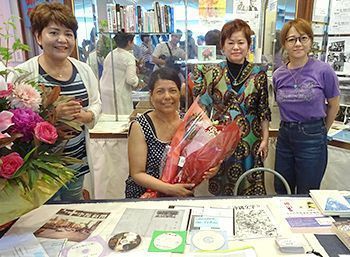
June 13, 2019 Ryukyu Shimpo
On June 2, University of California, Berkley Professor Eriko Ikehara, who has been researching the history of the black community in Teruya, Okinawa, opened the Koza X MiXtopia Research Center in the Gintengai Shopping Arcade. On the same day, an opening ceremony was held at the Teruya Community Center in which about 40 of her acquaintances attended. Ikehara spoke of her aspirations and said, “I hope to make this a place where a variety of people like local people and overseas researchers can learn from one another.”
Ikehara was born between an Uchinanchu mother and a black soldier father, and spent her childhood in Teruya. She was then adopted at the age of 14 in which she moved to the U.S. She has been researching her Okinawan roots from multiple angles through art and academic research. During her doctoral program at UC Berkeley, she researched the black community that was present in the Teruya area between the 1950s and around 1976, along with the lifestyles of local residents in the area. She did this by visiting Okinawa and creating a network for exchanging information and interacting with local residents at the Teruya Community Center, bars in the area, and the Gintengai Shopping Arcade. The network headquarters is based in Teruya.
The MiXtopia was established at the former Kanebo Plaza, which is next to a store that sells Kanebo cosmetics in the Gintengai Shopping Arcade. Ikehara is displaying material and photographs she has collected over the years with the hope of expanding her research into something multifaceted. She plans to record the untold history and stories of the Koza black community in various forms. She hopes that this will serve as a bridge between Okinawa and the U.S., along with utilizing the location to its potential.
Ikehara said, “There are some women who have gone over to the states as a result of being adopted or getting married that still have an attachment to Okinawa, but are unable to return. For the sake of Okinawa’s growth, I hope to create a place where those people can come home whenever they want.”
Okinawa City Promotion Division Section Chief Tetsu Fukuhara who attended the opening ceremony said, “If this could lead to revitalization by restoring the Koza Crossing and serve as a place for socialization, that would be great.”
(English translation by T&CT and Chelsea Ashimine)
Go to Japanese
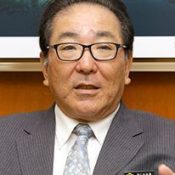
June 13, 2019 Ryukyu Shimpo
On June 12 Ie Village Mayor Hideyuki Shimabukuro spoke about the accepted scope of parachute drop training, and in regard to the U.S. military’s Ie Jima Auxiliary Airfield being the agreed-upon place for parachute drop training to be conducted in the Special Action Committee on Okinawa (SACO) agreement. He explained his perception that, “Based on the SACO final agreement parachute drop training is allowed where it was once conducted above the land of Yomitan Auxiliary Airfield, yet this does not include the ocean or other areas.”
After this recent training exercise took place at the Tsuken Jima ocean training area in Uruma City, which is not included in the agreement, Mayor Shimabukuro said, “The attitude that [training] at Ie Jima is natural and should be accepted is regrettable.” His statements took place on June 12 at a plenary session of the village assembly.
In the 1996 SACO Final Report, it was agreed that parachute drop training would be moved from Yomitan Auxiliary Airfield to Ie jima Auxiliary Airfield. Yet in 2007 the U.S.-Japan Joint Committee confirmed that Kadena Air Base could be used “only in exceptional cases.”
On May 21 the U.S. military conducted its third parachute drop training of the year at Kadena Air Base. Minister of Defense Takeshi Iwaya spoke the same day about this training at Kadena being limited to exceptional cases, saying, “I will ask the U.S. to conduct [training] at Ie Jima Airfield.”
However, it has been pointed out that training was conducted in the ocean at Tsuken Jima four times in May alone, which normalizes training there.
Mayor Shimabukuro expressed his viewpoint that, “In exceptional cases the training is to take place over the land at Kadena, it is not supposed to take place over the ocean.” He mentioned his concern that the U.S. military now has use conditions that allow it to conduct parachute drop training over the ocean at Tsuken, as addressed in U.S. military bases in Okinawa (issued by the Okinawa Prefectural Military Base Affairs Division).
Additionally, he expressed that although Ie Village is included in SACO, it does not mean Ie accepts it. He said the village begrudgingly accepts details as those might lead to consolidation and reduction of military bases, and alleviate the base burden on Okinawa. Furthermore, he expressed that the recent attitude of such training being accepted on Ie Jima is very unexpected and regrettable.
(English translation by T&CT and Erin Jones)
Go to Japanese
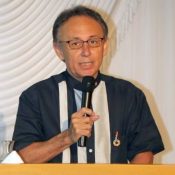
June 12, 2019 Ryukyu Shimpo
On June 11 Okinawa Governor Denny Tamaki started the first leg of his cross-country “talk caravan” at Le Port Kojimachi in Tokyo. This caravan will consist of lectures and symposiums, and is a move by the Okinawa Prefectural Government (OPG) to make those across Japan consider issues such as the construction of the Futenma Replacement Facility (FRF) being forced on Henoko, Okinawa, despite the clear demonstration of local opposition to its construction.
Speaking in front of about 200 people, Governor Tamaki addressed the situation of construction at Henoko. He said, “When the interpretation of the law keeps being distorted, Japan’s democracy and local autonomy do not hold true. These are not Okinawa’s circumstances alone. I want people to think as independent individuals and make their voices heard nationwide.”
Governor Tamaki’s aim is to arouse a nationwide discussion about the U.S.-Japan security treaty, under which an overlarge share of the U.S. military base burden is concentrated on Okinawa. This is the first Okinawan caravan travelling throughout Japan since the one conducted by Masahide Ota’s gubernatorial administration in 1996. Following this first stop, Governor Tamaki will visit major cities in each national block and share Okinawans’ opinions on his travels.
In his keynote speech, Governor Tamaki looked back on the history of Satsuma’s invasion of Ryukyu, saying: “Coercion by statesmen has continued to the present day. I want you to see that Henoko is the prime example of that, and to think about what you would do as a sovereign [in such circumstances].”
He once again emphasized that he cannot accept the FRF in Henoko, saying: “The government says that Henoko is the only solution. However, Okinawan citizens have received no explanation about what places Henoko is compared to in order to make it the only solution. Since the reason and logic behind Henoko being the sole solution do not stand up to scrutiny, we request an explanation. Something that cannot be explained cannot be implemented.”
Furthermore he criticized, “Judging by the government’s words and actions, it is not doing this for its citizens.”
On this day Governor Tamaki’s keynote speech was titled, We love Okinawa – Governor Tamaki kick-off symposium: Let’s listen to Okinawans and think collectively. Jinshiro Motoyama, who pushed for the Henoko prefectural referendum, also gave a report.
(English translation by T&CT and Erin Jones)
Go to Japanese
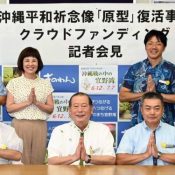
June 14, 2019 Ryukyu Shimpo
Ginowan – “Peace from Futenma.” Ginowan City in Okinawa announced June 13 that they have begun crowdfunding on the internet to raise the money to restore a prototype for a peace statue stored in a studio in Futenma, in order to eventually display the statue to the public. The statue itself was made by the late master artist Shinzan Yamada, and is stored at the Okinawa Peace Hall in Itoman.
Shinzan Yamada lived through the Battle of Okinawa, where he lost two sons, and spent 18 years building a prototype for a statue to mourn those lost in battle as well as to pray for world peace, completing the prototype in 1975. The estimate for restoring the prototype is around 500 million yen. The city hopes to raise around 3.5 million yen per year for each of the seven years until the proposed date for displaying the prototype publicly in 2025, for a total of 25 million yen. Additionally, on the crowdfunding site there is a “hometown choice,” which will run for 3 months from June 21 through September 20. Using the “benefit-your-locality” tax scheme, residents outside of Ginowan can use part of their residential tax to make a donation of over 10,000 yen.
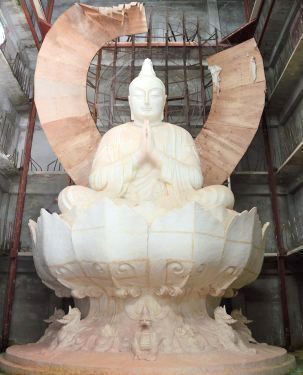
The prototype for the Okinawa Peace Prayer Statue built by Shinzan Yamada, stored in a studio in Futenma, Ginowan (photograph provided by Ginowan City)
The prototype display is part of the “MCAS Futenma area town-building project,” and the city plans to register it as a cultural asset. For questions, contact the city planning office at 098 (893) 4461 (telephone).
(English translation by T&CT and Sam Grieb)
Go to Japanese
Satoko Oka Norimatsu, Editor, The Asia-Pacific Journal: Japan Focus
“Here, our people demand that Japan and each nation of the world provide us an opportunity for self-determination. We hereby declare that if our demand is not met, we will attempt to achieve independence by taking free action for our people’s survival.”
These are the concluding sentences of the 2/8 Independence Declaration, dated February 8, 1919, drafted by a group of Korean students who were studying in Japan when Korea was under Japan’s colonial rule. The declaration sparked the 3/1 Independence Movement three weeks later in their homeland. I had the opportunity to attend a 100th anniversary ceremony for the declaration held at the Korean YMCA in Tokyo on February 8, 2019.
The language of the ceremony was Korean, but a representative from the Korean Residents Union in Japan (Mindan) addressed us in Japanese, saying, “To the Japanese people who took the courage to be here today…” Hearing that, I realized it hadn’t taken any courage for me to be there.
The ceremony was held to reflect on the history in which Japan, following its opening of the country, took steps to conquer Korea; specifically, the history in which, according to the 2/8 Independence Declaration, Japan’s “administration, court, police and other authorities violated the human rights of Korean people, established a discriminatory relationship between our people and the Japanese both in public and in private, provided inferior education to our people, and attempted to eternally use our people as servants of the Japanese.”
The words of Mindan’s representative made me feel ashamed, as I realized that I was sitting at the ceremony without sufficiently feeling the weight of this history.
After that, I stayed in Tokyo until March 1, the 100th anniversary of the 3/1 Independence Movement of 1919, in which two million people participated across Korea. Of the events I attended in honor of the anniversary, one that particularly moved me was a lecture held in Yokohama titled “Korean Women Who Resisted Colonialism” by Song Younok, professor emeritus at Aoyama Gakuin Unversity. There were so many women like Kim Maria, who participated in the 2/8 Independence Declaration, then later got arrested and underwent terrible torture. Song emphasized that women’s participation in the movement meant that they had to be ready to accept sexual torture and that even if they survived, they would have to persevere judgement in a society bound by Confucian values. I thought that it’s easy to praise the courage of these women, but I wondered if I would have been able to do what they did? I did not have an answer. There would have been no suffering like that to begin with if it were not for the Japanese colonization. All I can do is express my deepest respect for those women.
This March marks not only the 100th anniversary of the 3/1 Independence Movement but also the 140th anniversary of Japan’s forceful annexation of the Ryukyus on March 27, 1879, when the Meiji government destroyed the kingdom that had ruled there for nearly five centuries. The modern nation of Japan deprived the Ryukyu people of their ancestral languages, beliefs, culture, and pride, just as it did in Korea. The 100th anniversary of 3/1 and the 140th anniversary of 3/27 are connected, and Japanese people need to deeply inscribe both these histories into their minds.
Colonialism in both regions is still ongoing, and at its root is Japan’s alliance with the biggest military threat in the world–the United States. The Japan-U.S. Security Treaty thwarts unification and independence of Korea and concentrates military bases in Okinawa.
In a prefectural referendum held in Okinawa on February 24, over 70 percent of those who (with 52 percent of eligible voters participating in the referendum) opposed the construction of a new U.S. Marine base in Henoko. It was a reaffirmation of what we all knew already, but for many Okinawans, this referendum signified an expression of their demand to the Japanese government for the right to self-determination.
Ironically, on the very day of the referendum, something happened that symbolized Japan’s colonialism against Okinawa. A national ceremony in Tokyo to celebrate the 30th anniversary of Emperor Akihito’s emperorship had an Okinawan singer perform a Ryukyu-style song the lyrics of which were written by Emperor Akihito and the music of which was composed by Empress Michiko. I could not believe my eyes.
Canada, where I live, is a nation built on the first peoples’ land by English and French colonists, of which the head of state is the Queen of the United Kingdom. Canada designates a Governor General as representative of the Queen. If, for example, the Governor General of Canada had an indigenous artist perform an indigenous-style song that she wrote herself in an indigenous language for her own celebration, that would be regarded as an act of cultural appropriation and would undoubtedly cause an uproar of criticism across the nation.
At the emperor’s ceremony, Abe even unabashedly led a “Long Live His Majesty Emperor (tenno heika banzai)!” chant. What has this country learned from the history of the Empire of Japan?
However, there was hardly any criticism of this from Japanese “liberals.” Why? Is it not because of the “emperor taboo”? Japan expanded its empire under the name of the emperor. Any discourse on Japan’s colonialism cannot be separated from the emperor system. As long as it is considered taboo to criticize the emperor system, and as long as society as a whole suppresses any discussion or question regarding it, we cannot call this country a democracy.
As we reach the 100th anniversary of the Korean 3/1 Movement and the 140th anniversary of the 3/27 Ryukyu annexation, I feel that there is a long way ahead for Japan to overcome its colonialism, but I, with clear awareness of historical responsibility as a Japanese person, want to learn from history, and want to be part of an effort to build a peaceful future with my fellow Asians.
Above is the gist of the speech I gave at a big rally to commemorate the 100th anniversary of 3/1 in front of the Studio ALTA building in Shinjuku, Tokyo, as I was deafened by the angry yells of right-wingers who were there to sabotage us. I felt like I was standing at the entrance to an endless journey of learning.
This is an English version of the author’s article, the 24th of her column series Norimatsu Satoko no me, which appeared in Ryukyu Shimpo on March 10, 2019.
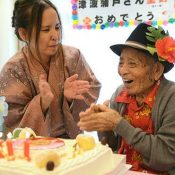
June 11, 2019 Ryukyu Shimpo
Kamado Tsuha’s secret to staying energetic at 111 is Okinawan andagi donuts. On Jun 10, Tsuha, the oldest man living in Okinawa, celebrated his 111th birthday in Yomitan Village. His birthday party was held at the nursing home Tsuha currently resides. Mayor Denjitsu Ishimine and FC Ryukyu forward Yukihide Gibo joined Tsuha’s family to celebrate his longevity; Tsuha has lived to see five imperial eras, from Meiji to Reiwa. The table was set up with his favorite andagi donuts, and guests came bearing more. He repeated“achabiyo!” in excitement, an Okinawan phrase for “Oh my goodness!”
For the occasion, the supercentenarian dressed in a bright red kariyushi shirt, (Okinawa’s answer to aloha shirts) and a hat adorned with a hibiscus flower. He was met with an applause as he walked into the room with a care taker at his side. Tsuha was nicknamed “Happy” at a young age, owing to his trademark smile and kind personality. He thanked his guests with the same big smile as they congratulated him.
Tsuha took a big bite of his birthday cake, demonstrating his appetite remains unaffected by age; but he told the home’s director, Ikuko Kakazu, he preferred andagi to the birthday cake. After the meal, he danced the Okinawan kachashi with the help of his care takers, amazing the party-goers.
Born in 1908, Tsuha worked as an automotive painter to raise two sons and four daughters. His youngest daughter Yoshiko Chibana, 74, wished for her father to “stay healthy and be full of life for years to come.”
(English translation by T&CT and Monica Shingaki)
Go to Japanese

June 9, 2019 Ryukyu Shimpo
On June 8 media coverage at the Okinawa Defense Bureau (ODB) found that over the last six years, out of all landowners who own Okinawan land being contractually leased out for U.S. military base use, the number of these landowners residing outside of Okinawa has increased by 1.44 times to more than 4,000 individuals. Now, those residing outside of Okinawa account for nearly 10 percent of all such landowners. This is due in part to landowners aging, and passing down their land down to relatives living outside of Okinawa and abroad. Also, it appears that ownership of U.S. military-used land has become increasingly desirable as a risk-free asset, due to an environment of unprecedentedly low interest rates.
In 2012 when the ODB began differentiating between landowners living in Okinawa and outside Okinawa, there were 44,233 landowners in total. At that time, those living outside of Okinawa numbered 2,786, accounting for only 6.3 percent of all such landowners. The latest statistics from 2018 show that out of a total of 44,523 landowners, the number of those residing outside Okinawa has increased to 4,027, now accounting for 9.0 percent of all such landowners.
Over the six consecutive years during which data on these landowners has been monitored the total number of landowners has appeared to grow or shrink depending on the year, yet the number of landowners residing outside the prefecture has increased each year. Out of 44,034 landowners in 2017, 3,488 individuals or 7.9 percent of all such landowners resided outside of Okinawa. 2018 marked a significant growth in this number.
The number of landowners of land used for Japan Self-Defense Force (JSDF) bases residing outside of Okinawa has also been increasing for six consecutive years. Out of 7,876 such landowners counted in 2018, 935 individuals or 11.9 percent resided outside of Okinawa.
Landowners who have not agreed to have their land used for U.S. military bases and have not entered into contracts with the State are not included in these numbers. As for the land that has not been consented for military base use, Japan forces compliance based on the Act on Special Measures for USFJ Land Release. There are 2,032 landowners without contracts living in Okinawa, and 2,125 living outside of Okinawa.
According to the ODB, on January 1, 2019 out of all U.S. military exclusive-use facilities and territory, approximately 7,380.8 hectares of private land was being used, accounting for about 40 percent of all U.S. military exclusive-use base land.
(English translation by T&CT and Erin Jones)
Go to Japanese
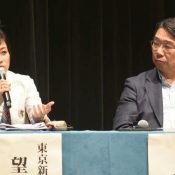
June 8, 2019 Ryukyu Shimpo
A symposium titled, “The Authority of the Prime Minister’s Office and the Status of Journalistic Media,” (hosted by Ryukyu Shimpo Co. Ltd., sponsored by Star Sands, in collaboration with Aeon Entertainment) held as part of the opening for the movie “Shimbun Kisha,” (English: Newspaper Reporter) was held the evening of June 7 at the Ryukyu Shimpo Hall in Izumizaki, Naha. Isoko Mochizuki from the Tokyo Shimbun and former Vice Minister of Education, Culture, Sports, Science and Technology (MEXT) Kihei Maekawa spoke at the event, where they exchanged their views on the pressure the current administration is putting on journalists, as well as the current state of the media in terms of their role in oversight for political authority. A little over 700 people were in attendance.
Mochizuki spoke about her experience of having her questions limited for repeatedly asking tough questions at a Chief Cabinet Secretary press conference, as well as how the current administration in Japan is manipulating the media. Additionally, she stressed, “The media is not a tool that to be used at the pleasure of the government, but is tasked with the role of government watchdog. It is important that we return to the media’s original role of providing oversight for political authority.”
Maekawa spoke about his time serving as vice minister in the top office at MEXT, as well as false reporting that seems to have come from leaked information from the office of the prime minister. He harshly criticized the media, saying, “They are not fulfilling their role of conveying the truth to the people of Japan. They are being used as tools for government propaganda, and to attack opponents of the [Abe] administration.”
The 600 people packed into the auditorium loudly applauded the opinions given by the two speakers. There were also around 100 people watching on screens on the first floor of the lecture hall.
Clips from the movie “Shimbun Kisha,” which is based on Mochizuki’s books, were also shown at the event.
(English translation by T&CT and Sam Grieb)
Go to Japanese
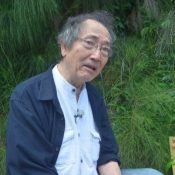
June 7, 2019 Ryukyu Shimpo Digital Edition
(Henoko reporting team) On June 7, around 30 citizens participated in a sit-in in front of U.S. military Camp Schwab in Henoko, Nago, where construction work for a new base is underway as part of the relocation of U.S. Marine Corps Air Station Futenma. The citizens raised their voices saying, “Give back Henoko” and “We don’t need a base.” Actor Masane Tsukayama, of Naha, participated in the sit-in, saying, “I’m vehemently opposed to the construction of a base connected to war.”
At sea, the Okinawa Defense Bureau continued unloading soil and sand from the K9 embankment on the Oura Bay side of the construction site. Citizens in seven kayaks and one boat protested against the base construction.
(English translation by T&CT and Sandi Aritza)
Go to Japanese
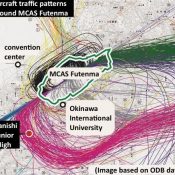
June 6, 2019 Ryukyu Shimpo
On June 5 the U.S. Marine Corps confirmed that an object from a helicopter stationed at Marine Corps Air Station Futenma (MCAS Futenma) fell onto the grounds of Uranishi Junior High School in Urasoe City, Okinawa. The object was a piece of blade tape from one of the helicopter blades, and due to its size and weight it “poses no threat to people or property.” However, something falling from an aircraft could easily cause bodily harm and lead to a serious incident.
In December 2017, too, a window from a CH-53E helicopter stationed on MCAS Futenma fell onto the nearby Futenma Daini Elementary School. This most recent falling part incident has made people recognize anew the dangers of MCAS Futenma, and has intensified concerns involving safety in Okinawa and municipalities surrounding MCAS Futenma.
One of MCAS Futenma’s airfield traffic patterns exists over Uranishi Junior High School in Toyama, Urasoe City, onto which the rubber piece from a U.S. military aircraft fell on the afternoon of June 4. Some U.S. military aircraft that take off from or land on the south side of MCAS Futnema fly directly over the school. This falling object incident has vividly demonstrated the dangers faced by not only Ginowan City, where MCAS Futenma is located, but by municipalities near the air station over which its traffic patterns exist.
According to the results of a U.S. military aircraft track study, which were released by the Okinawa Defense Bureau (ODB) in December 2018, there are flight paths over municipalities including Urasoe City, Nakagusuku Village, and Kitanagusuku Village. After the U.S. military helicopter crash on Okinawa International University in 2004, the U.S. and Japanese governments reviewed flight paths in the vicinity of MCAS Futenma, and decided to avoid the air space over private land to the degree possible. Although there are established traffic patterns in the air surrounding MCAS Futenma, it has been confirmed that flights largely divert from these paths.
Due to the blade tape the U.S. Marine Corps let fall on June 4 being lightweight, it has been argued that the tape “poses no threat to people or property.” Yet, due to successive incidents including a CH-53E helicopter’s window falling onto Futenma Daini Elementary School, and the issue of an aircraft part being found on Midorigaoka Nursery School in Nodake, Ginowan City, there are deep-rooted concerns for the safety of residents in the areas surrounding MCAS Futenma.
In December 2018 the ODB publicized results on its website from the U.S. military aircraft track study around MCAS Futenma. Yet, there was a request from the U.S. to discontinue the results’ availability to the public. A U.S. official stated that it is essential to take into account risks faced by the U.S. military in the international community, and to more seriously consider preservation of information relating to the use of aircraft. These results are no longer publicly available on the ODB website.
(English translation by T&CT and Erin Jones)
Go to Japanese

June 6, 2019 Ryukyu Shimpo
Around 3:30 p.m. on June 4 an object that appears to be a piece from a U.S. military aircraft fell onto the tennis court of Uranishi Junior High School in Toyama, Urasoe City. On June 5 the U.S. Marine Corps in Okinawa assessed the object had fallen off of a CH-53E helicopter from Futenma Air Station. The object is a piece of blade tape, which can be applied to Marine Corps helicopter blades. A Marine Corps official assessed that judging by the object’s weight and size, it “poses no threat to people or property.” The official emphasized that the “1st Marine Aircraft Wing is inspecting all aircraft that have blade tape and will remove or replace any blade tape that is found to be degraded.”
Due to successive U.S. military-related accidents, such as the incident in December 2017 in which a CH-53E helicopter’s window fell onto the grounds of Futenma Daini Elementary School in Ginowan City, opposition from within Okinawa and Urasoe City has increased.
On the evening of June 5 Okinawa Vice Governor Kiichiro Jahana spoke with the press and said: “We must conclude that the U.S. military’s maintenance and control of its helicopters are insufficient. It stirs concern among people in the prefecture and is extremely deplorable.” He thinks that the CH-53E helicopters should not be flown until the U.S. military has investigated the cause of the accident, announced its findings, and disclosed all related information.
That same day, Urasoe City Mayor Tetsuji Matsumoto held an urgent interview at the Urasoe City Office, and expressed that he wants the U.S. and Japanese governments to take steps to maintain safety, including stopping flights of CH-53E helicopters.
According to the Okinawa Prefectural Government and the U.S. Marine Corps in Okinawa, the object that fell is rubber, measures 18 centimeters long and 12 centimeters wide, weighs 20 grams, and is meant to be applied to the forward edge of helicopter blades to protect them from deterioration and damage. In Okinawa, this blade tape is used not only on the U.S. Marine Corps’ CH-53E helicopters, but also its AH-1 helicopters, its UH-1 helicopters, and its MV-22 Osprey.
In the evening on June 4, even after the part fell in Urasoe, the U.S. military conducted CH-53E helicopter training at Futenma Air Station. It was confirmed that a CH-53E helicopter was serviced in the evening on June 4 on an aircraft parking apron at Futenma Air Station.
(English translation by T&CT and Erin Jones)
Go to Japanese











 Webcam(Kokusai Street)
Webcam(Kokusai Street)


